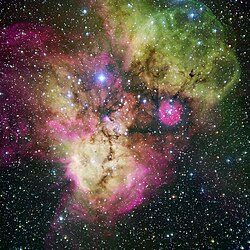| Observation data Epoch J2000.0 [1] Equinox J2000.0 [1] | |
|---|---|
| Constellation | Puppis |
| Right ascension | 07h 53m 38.20519s |
| Declination | −26° 14′ 02.5981″ |
| Apparent magnitude (V) | 9.39 [2] |
| Characteristics | |
| Evolutionary stage | Main-sequence star |
| Spectral type | O3V((f*))z [3] |
| U−B color index | −0.86 [2] |
| B−V color index | 0.11 [2] |
| J−H color index | 0.001 [4] |
| J−K color index | 0.008 [4] |
| Astrometry | |
| Radial velocity (Rv) | 87.1±5.7 [5] km/s |
| Proper motion (μ) | RA: −0.535 [1] mas/yr Dec.: 4.115 [1] mas/yr |
| Parallax (π) | 0.2241±0.0177 mas [1] |
| Distance | 15,000 ± 1,000 ly (4,500 ± 400 pc) |
| Details [5] | |
| Mass | 57 [6] M☉ |
| Radius | 14±2 [6] R☉ |
| Luminosity | 500000+290000 −180000 [6] L☉ |
| Surface gravity (log g) | 3.91±0.08 cgs |
| Temperature | 44900±1700 K |
| Rotational velocity (v sin i) | ≤117±13 km/s |
| Other designations | |
| CD−25° 5228, CPD−25° 3039, Gaia DR2 5602033390154015744, HD 64568, HIP 38548, SAO 174748, PPM 253404, TIC 128808726, TYC 6557-214-1, GSC 06557-00214, 2MASS J07533820-2614025, DENIS J075338.2-261402, NGC 2467 77 [7] | |
| Database references | |
| SIMBAD | data |
HD 64568 is a massive solitary [8] star in the southern constellation of Puppis. With an apparent magnitude of 9.39, it is too faint to be seen by the naked eye, but can barely be observed by binoculars, appearing as a blue-hued dot of light. It is located approximately 4,500 parsecs (15,000 light-years) distant according to Gaia EDR3 parallax measurements.

